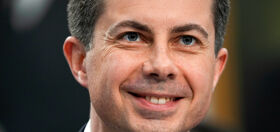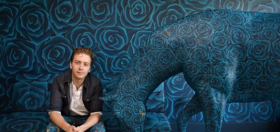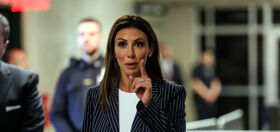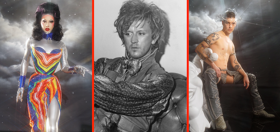
We hope you’ve had a chance to read the first part of Matt Sussman‘s exploration of The Scarlet Pansy. If not, catch up so you can enjoy part two, buster!
After first discovering this vintage gay text, our hero couldn’t shake the feeling that something wasn’t quite right. With a little research and a lot of gumption, he delved into a world of literary hot-rodding, government regulations, and secret dealings, all of which led him to the mysterious Dr. Hugh Hagius.
Picking up where part one ended, we find our hero about to shed some light on Hagius, discover The Scarlet Pansy‘s origins, the real author’s identity, and the aftermath of its publication. As it all comes together, Sussman reaches some eye-opening conclusions.
Earlier: Words on Homo Words: The Scarlet Pansy

Hugh Hagius PhD, started out building computer systems for Wall Street brokerage houses, but quit to pursue his interests in writing about and researching arcane gay-themed books. After first reading The Scarlet Pansy in the 70s, he says, “[The novel] stayed in my head. It wasn’t like anything else I had read, and I felt there was some back story to it, if I could only pry it open.” Through comparative readings of the novel against McAlmon’s correspondences, his other writings and those of his literary peers, Hagius’ research resulted in the fifty-two page report that meticulously makes the case that Robert Scully and Robert McAlmon (pictured) were, in fact, the same person.
How about we take this to the next level?
Our newsletter is like a refreshing cocktail (or mocktail) of LGBTQ+ entertainment and pop culture, served up with a side of eye-candy.
As much as Pansy offers a rare glimpse into the prewar urban gay life, Hagius insists that it be read as McAlmon’s arch roman-a-clef, satirizing the members of his inner circle -which included William Carlos Williams, and McAlmon’s real-life wife/beard heiress, Winifred “Bryhyr” Ellermen, companion to poet H.D. – along with the bohemian literary demimondes of New York and Paris in the 1920s and 1930s. In the most conjectural part of his thesis, Hagius posits that McAlmon – past his glory days of showing Hemmingway around Spain and publishing Gertrude Stein – failed to find a taker for his new novel, “shocking in what it says and knows,” due to his strained literary contacts and washed-up reputation. In a last ditch effort, he sold his manuscript to Roth for a lump sum, slapped on a pseudonym and the rest is history.
Hagius put out a follow-up essay ten years later entitled, “Fay Etrange in Sex Change,” in which he explicates the novel’s post-30s publishing history and clears up the Badboy discrepancies in the style of a mock news report, complete with an “interview” with a post-post-op Fay Etrange who dishes on her “Badboy sex change.” The Badboy edition was based on a 1952 edition put out by Royal, which according to Hagius, Roth himself slimmed by 20%, cutting out some of the topical allusions and much of the fantastic conversation of the original. All and all, Hagius estimates that Pansy has gone through at least half a dozen editions over its 75 year existence.
Aside from its weaknesses as a novel, perhaps Pansy has remained such a marginal text because what little critical attention it has received has been largely dismissive, treating it as a stereotype-laden, if not amusing, footnote on the “road to stonewall,” to paraphrase the title of Byrne Fone’s survey of pre 1968 gay-themed literature. Hagius quotes more negative, post-Stonewall opinions of Pansy, with one un-attributed critics deriding it as: “The low point of the homosexual novel!” In a 1978 survey of interwar gay fiction for wonderfully-titled fag rag, The Gai Blade CUNY Professor Jim Levin writes: “while giving us a clear picture of the public side of the gay subculture, Scully is also showing that this is a world inhabited only by those men and women who have given up any hope of social acceptance. To his credit he does this with humor and satire.”
As with the bits of critical vitriol Hagius cites, it’s important to keep in mind when Levin is writing. 1978 was arguably the crest of gay liberation’s first wave, before the monstrous ascendancy of AIDS, when activists were aiming to politicize gay public life and publicize gay politics. The twilight modes of pre-Stonewall public gay existence–as Fay reminds us in a Wildean nugget of wisdom: “passing is the only way to be respected and disreputable at the same time”– gave way to marches, parades, street fairs, political rallies and impromptu public parties, a shift summed up by the popular slogan, “Out of the bars and into the streets.”

What these critics overlook (although Levin does acknowledge this somewhat) is that for all of its stylistic airs -and regardless of who really wrote it – Pansy offers a remarkably nonjudgmental and surprisingly frank depiction of the lives of urban gay men in the thirties, something that was obscured in my initial reading by all the x-rated cotton candy padding of the Badboy edition. Fay’s climactic death reads less like the mandatory narrative offing of the homosexual and more like a spoof on the conventions of the tawdry romance paperbacks in fashion at the time. Never mind that Pansy is the first instance in which cruising for sex appears in a novel. As Hagius notes in his essay, “Fay inhabits a world in which people are open and honest about their erotic lives, and the individual’s sexuality fixes her position in society.” Sexuality may fix one’s position, but that doesn’t necessarily mean there’s no room for slippage; specifically in regards to language. As much as Fay is reminded that her voice and speech “give her away,” it is the queer intonations and proclamations which echo throughout the novel that form another scene–perhaps only tenable as an acoustic one. “Camping” forms the shared linguistic ground on which the novel’s incipient communities are formed in bars, at balls, and in all-night restaurants. And of course, being well versed in the cues of body language and inflection can easily ensure a night’s worth of dalliances.
At one point a drag queen named Miss Kitty recounts to a salon her “wish-fulfillment daydream” of a blissful island paradise, “where we could all live or go to easily whenever we pleased and do all the things we wish to do without thought of the narrow-mindedness of others.” Responding to her Auntie’s protestation that she’s asking to much, Miss Kitty counters that sexual variation (“natural morality” in her dainty parlance) should not be barred by the law and that people “have no right to criticize those who indulge in love for love’s sweet sake, and by love you know what I mean–no matter how a person may love.” Despite the camp deflections that follow it (Old Aunt Minnie: “Are you talking about sexual aberration now?” Miss Kitty: “Well, I’d not call anything by such a lewd-sounding name. I’m elegant, I am.”), Miss Kitty’s declaration is the most striking moment in the novel, not the least for the faint stirrings of political consciousness that seem detectable beneath all the rhetorical mincing. Like the language of Fay and company, it serves as a countermand–however limited in range–to the injunction towards “social acceptance.”

Levin concludes his study with a sober reiteration of the saying that those who forgot the past are condemned to repeat it: “[Interwar gay novels] with all their negations, at the very least serve to remind us of a world we are well rid of, but which we forget at our own peril.” Indeed, many of the novels he catalogues–Blair Niles’ Strange Brother (1931), Charles Henri Ford’s and Parker Tyler’s The Young and Evil (1933), and James M. Cain’s Serenade (1937) to name a few of the better known volumes– read as warnings to the uninitiated and perhaps curious reader that “the public gay world is hell itself.” The price of admission is guaranteed eternal loneliness punctuated by the transitory pleasures of the flesh, and more often than not, one’s life. However, Pansy offers a respite–as brief and breezy as it may be–from the literary chamber of horrors laid out in other homosexual-themed novels of the time. It essays both the risks and pleasures of public gay life (often locating the pleasure in the risk), and celebrates its characters who “burlesque all life” and pursue their sexual gratification without compunction, as much as it shows them unfulfilled in other, albeit predictable, ways (professional and financial success just aren’t enough for Fay; she also wants true love). To overlook A Scarlet Pansy as a gay classic would be to miss out on its exceptional fabulousness. But in doing so, we also forgo its fabulous exceptionality at our own peril.
(Acknowledgements: I would like to thank Dr. Hugh Hagius for generously sharing his work with me; Michael Bronski and Richard Kasak for providing their knowledge and helpful suggestions; Bolerium Books for trusting me with their first edition; Joey Plaster for his enthusiasm and for first exposing me to the novel; the One Institute and LGBT Archives for research assistance; and Fay.)

















Noah Miller
Where is part 1 of this article? The “earlier” link is broken.